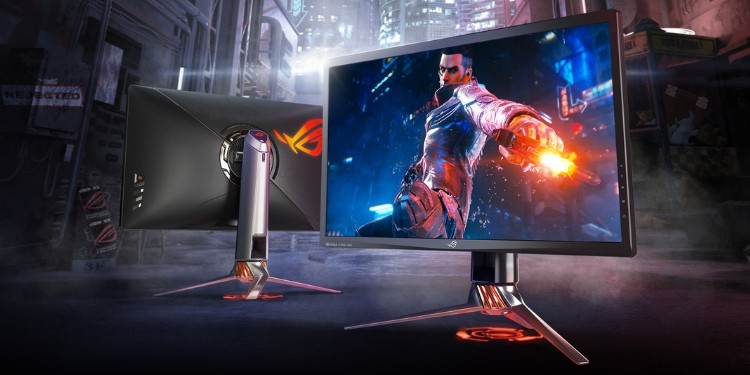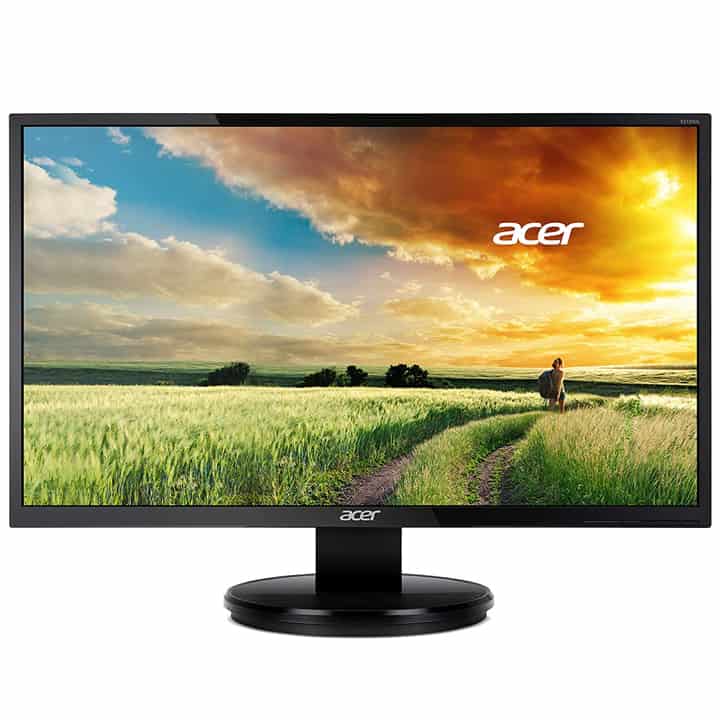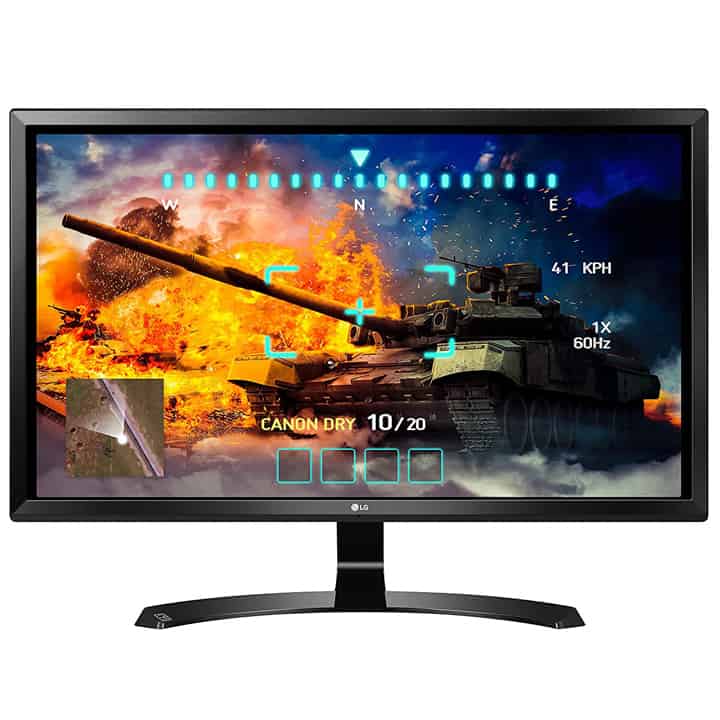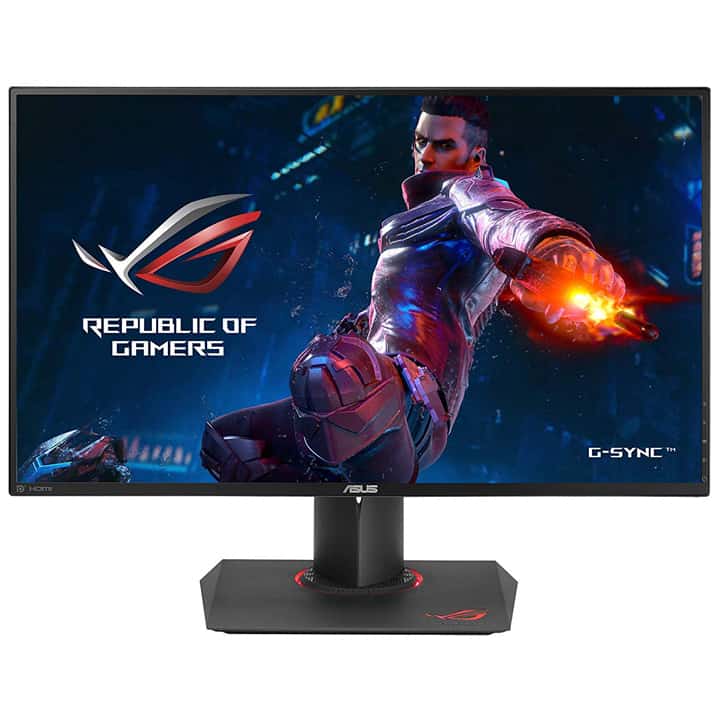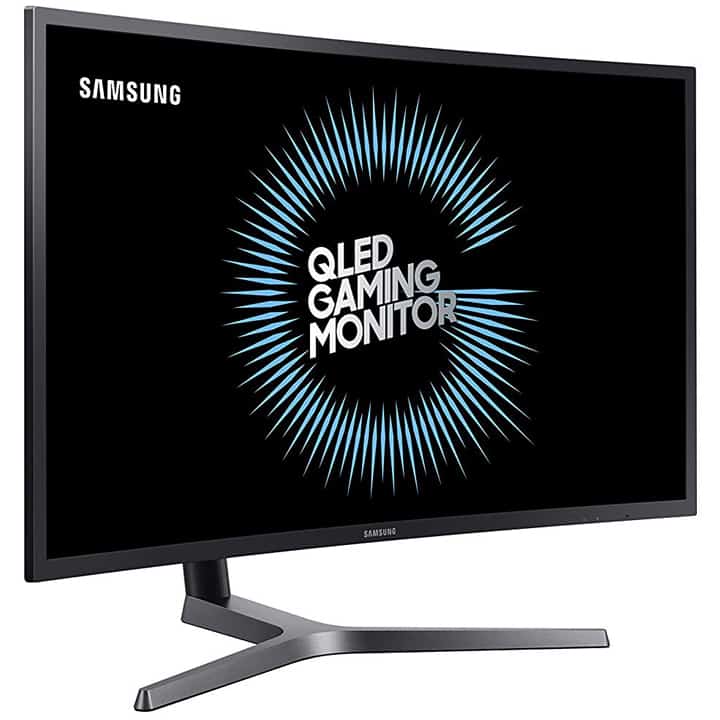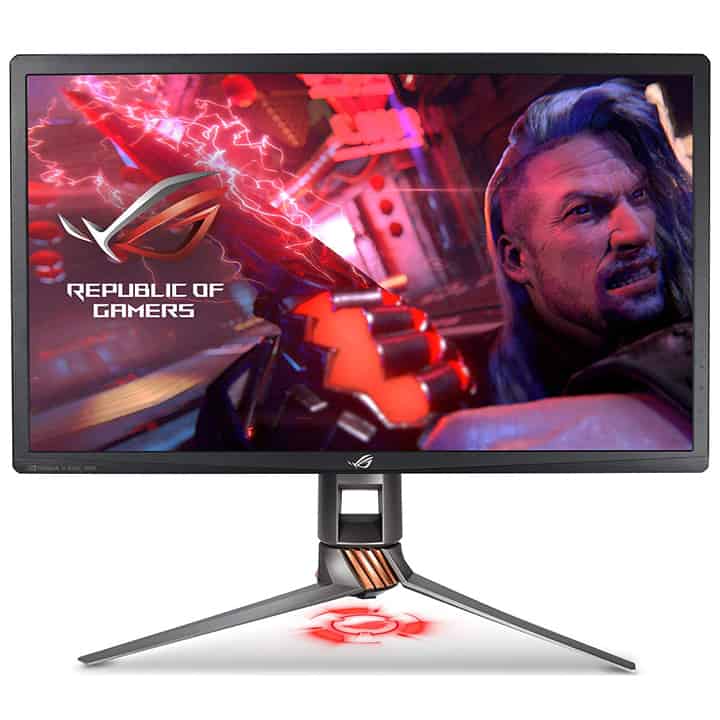Compared to your traditional 24-inch display, there are many benefits to a 27-inch computer monitor. For one, it takes up more of your field of view than a 24-inch monitor would at an equivalent distance. This allows for more immersive gaming and better screen real estate for multitasking and productivity.
However, this larger size comes with a downside: you’ll want to go with a higher-resolution panel to preserve ideal pixel density and clarity. For that reason, you shouldn’t be buying a 1080p 27-inch monitor: 1440p is essentially your minimum requirement for a good experience. If you’re worried about finding the ideal 27-inch LED monitor, don’t be: we’ve selected five top picks for you to choose from below.
Each of our reviews includes detailed specs, PPI measurements, a set of pros and cons, and our own thoughts.
best under $200
Acer K272HUL Ebmidpx
- Resolution: 2560 x 1440 (Quad HD)
- PPI: ~109
- Refresh rate: 60 Hz
- VRR: N/A
- Response time: 1 ms
- Panel type: TN
best under $300
LG 27UD58-B
- Resolution: 3840 x 2160 (4K Ultra HD)
- PPI: ~163
- Refresh rate: 60 Hz
- VRR: FreeSync
- Response time: 5 ms
- Panel type: IPS
best for gaming
ASUS ROG Swift PG279QZ
- Resolution: 2560 x 1440 (Quad HD)
- PPI: ~109
- Refresh rate: 144 Hz (165 Hz OC guaranteed)
- VRR: G-Sync
- Response time: 4 ms
- Panel type: IPS
Great 144 Hz refresh rate
Samsung CHG70
- Resolution: 2560 x 1440 (Quad HD)
- PPI: ~109
- Refresh rate: 144 Hz
- VRR: FreeSync 2
- Response time: 1 ms (MPRT)
- Panel type: VA
best overall
ASUS ROG Swift PG27UQ
- Resolution: 3840 x 2160 (4K Ultra HD)
- PPI: ~163
- Refresh rate: 144 Hz
- VRR: G-Sync HDR
- Response time: 4 ms
- Panel type: IPS
Table of Contents
1. Acer K272HUL Ebmidpx
This display from Acer is the best 27 inch monitor under $200
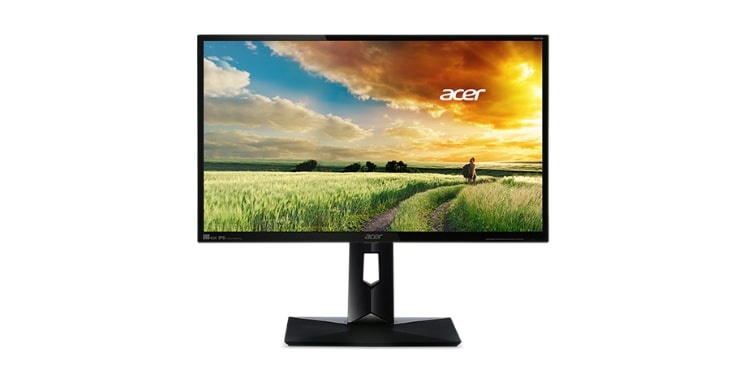
- Resolution: 2560 x 1440 (Quad HD)
- PPI: ~109
- Refresh rate: 60 Hz
- VRR: N/A
- Response time: 1 ms
- Panel type: TN
- Lowest price we could find
- TN panel is great for competitive gaming
- Most report good OC headroom
- No VRR
- TN panel is worse for color reproduction and viewing angles
If all you want is the best budget 27-inch monitor, this is the display for you. The Acer K272HUL Ebmidpx is our pick for best 27-inch monitor under $200 (though its price does fluctuate a small amount above sometimes). Even if it is slightly above $200 when you look at it, though, it’s still the cheapest we’ll recommend-- and among the cheapest we could find.
If you’re upgrading from a 22 or 24-inch 1080p monitor, you’ll enjoy quite the step up here. The larger screen size offers great screen real estate and is particularly useful when sniping in FPS games, where it’s much easier to pick out objects at a distance. This panel’s 1440p resolution keeps up with the increase in size, resulting in an even clearer image than what you’d get on a 22-inch 1080p monitor.
While the TN panel may not provide superb color reproduction or viewing angles, it does pull its weight in gaming. Most report good overclocking headroom on this monitor, meaning you should be able to push it to 75 Hz with few issues. The 1 ms response time, TN panel, and refresh rate overclocking all add up to a solid 1440p gaming experience for fairly little money.
The only thing we really hold against this monitor is the lack of VRR technology, but hey-- you can’t get everything you want here. Fortunately, AMD and Nvidia offer some strong solutions to prevent screen tearing without using full-blown in-game V-Sync.
2. LG 27UD58-B
The 4K LG27UD58-B is the best 27-inch monitor under $300
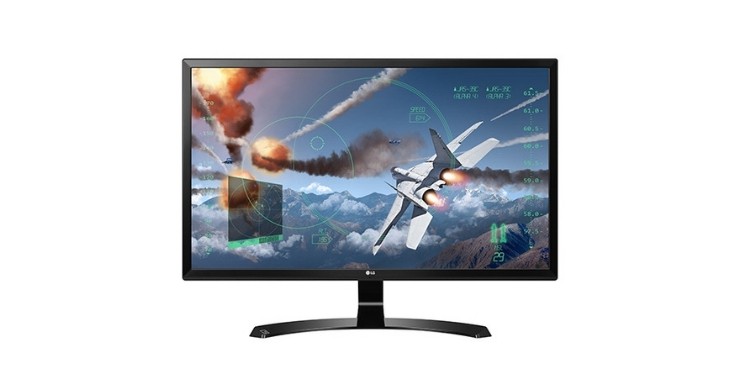
- Resolution: 3840 x 2160 (4K Ultra HD)
- PPI: ~163
- Refresh rate: 60 Hz
- VRR: FreeSync
- Response time: 5 ms
- Panel type: IPS
- Superb 4K resolution and PPI
- FreeSync supports AMD and Nvidia GPUs
- IPS panel offers superb colors and viewing angles
- Understandably, not much OC headroom
- Response time is a little high
At the time of writing, the best 27-inch monitor under $300 is an incredible 4K display from LG. For just under $300, you get a superb viewing experience, matched by little else on the market. Full 4K resolution and a high-quality IPS panel provide stellar color reproduction and viewing angles. The 60 Hz refresh rate is a little basic, but the addition of FreeSync on top of it helps provide a better gaming experience.
On the note of gaming, the refresh rate isn’t very overclockable. In our own tests, we were able to push Hz by less than five, and even then that still saw visual glitches-- honestly, it’s best to keep this one at 60 Hz. The 5 ms response time may be slightly alarming, too, but the input latency is actually fairly low. This is one of those cases where response time doesn’t tell the whole story.
If your priority is serious eSports gaming, this isn’t the monitor for you. You’ll want something better (144hz and likely 1440p if you expect to hit that framerate). This monitor is more for non-competitive gamers and general users who want the best possible viewing experience for the money. With some confidence, we say this fits the bill.
3. ASUS ROG Swift PG279QZ
The ASUS ROG Swift PG278QR is the best 27-inch monitor for gaming
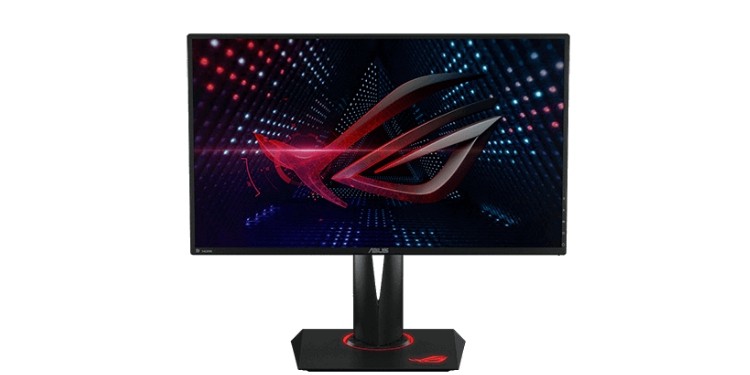
- Resolution: 2560 x 1440 (Quad HD)
- PPI: ~109
- Refresh rate: 144 Hz (165 Hz OC guaranteed)
- VRR: G-Sync
- Response time: 4 ms
- Panel type: IPS
- Superb 144 Hz refresh rate with guaranteed 165 Hz OC
- IPS panel for great colors and viewing angles
- G-Sync provides best experience for Nvidia users
- G-Sync doesn’t support AMD GPUs
- High price; no HDR support
The ASUS ROG Swift PG279QZ is a favorite in the PC gaming community right now. It’s a fully-featured 27-inch gaming monitor, offering a 144 Hz refresh rate, a superb 1440p IPS panel, and G-Sync. This, along with ASUS’ ROG brand recognition, has helped keep the ROG Swift consistently in top sellers and “best of” lists, including our own.
Our only issue with the monitor inherently is its high price-- you are paying for branding here, especially G-Sync. (Since FreeSync supports both vendors and G-Sync is more expensive while only supporting one… we’d daresay that G-Sync may actually be the worse standard now.) Even with that being said, it’s hard to deny just how good the product you’re getting is.
The combination of 1440p and 144 Hz by itself would make this monitor an instant buy for many gamers, especially those using high-end GPUs. This will translate to a superior gaming experience than anything possible on a 60 Hz monitor, TN or not. (For professional gamers who prefer TN: we’ve included an alternative linked below.)
The list of features, the solid build quality, and the plentiful adjustment options add up to make the ROG Swift PG27QZ the best 27-inch monitor for gaming. Some may even argue it’s the best monitor for gaming overall, and truth be told… we’d be hard-pressed to disagree.
Want a cheaper TN panel? The Dell S2719DGF might be right for you.
4. Samsung CHG70
The Samsung CH670 is the best 27 inch HDR monitor
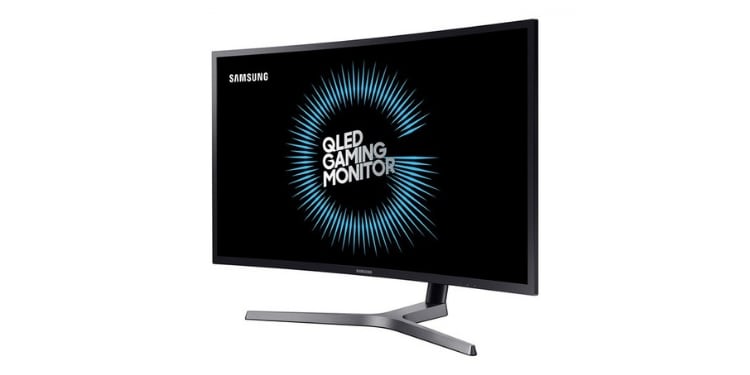
- Resolution: 2560 x 1440 (Quad HD)
- PPI: ~109
- Refresh rate: 144 Hz
- VRR: FreeSync 2
- Response time: 1 ms (MPRT)
- Panel type: VA
- Great 144 Hz refresh rate VA panel
- FreeSync 2 supports AMD and Nvidia GPUs
- VA panel offers a boost over TN
- The best HDR implementation on PC, bar none
- Misleading MPRT response time-- true GTG is probably closer to 5 ms
The Samsung CHG70 is another favorite gaming monitor and stands out as a 27-inch display. This is our pick for best 27 inch HDR monitor since it’s really the only monitor that pulls off HDR particularly well.
For reasons related to… well, the limitations of physical space, HDR is much easier to execute on a larger display than it is on a smaller one since it requires a much more powerful and intricate lighting solution. Combine that with a VA panel, which can actually show off deeper blacks than IPS, and the CHG70 can actually show off a better picture in HDR-supported content than any other display on this list.
HDR support is somewhat limited, especially on PC. It’s also more of a TV thing than a PC thing. We recommend this monitor for those who actually have a lot of HDR content to play, namely gamers using the Xbox One S/X or the PS4 (Pro). As far as gaming goes, the consoles currently have the best HDR implementations. If you have these consoles, especially an Xbox One X (which supports the FreeSync in this monitor), then this is definitely the monitor for you.
In that light, this isn’t just the best 27-inch HDR monitor: it’s the best monitor for console gaming, too.
Even if you aren’t playing on console, though, this monitor does have some nice things to offer. The VA panel trades blows with IPS when it comes to color reproduction; its great darks are where it really lands its major blows. Even outside of HDR-supported titles, you still get to enjoy a curved display, FreeSync 2, and a 144 Hz refresh rate, which guarantees a great gaming experience.
We do feel that the MPRT response time measurement of 1 ms is a bit misleading (the number is likely 4-5 ms in GTG), but this is still a great monitor. Get it if you’re a console gamer or really amped about HDR.
5. ASUS ROG Swift PG27UQ
The ROG Swift PG27UQ is the best overall 27 inch monitor
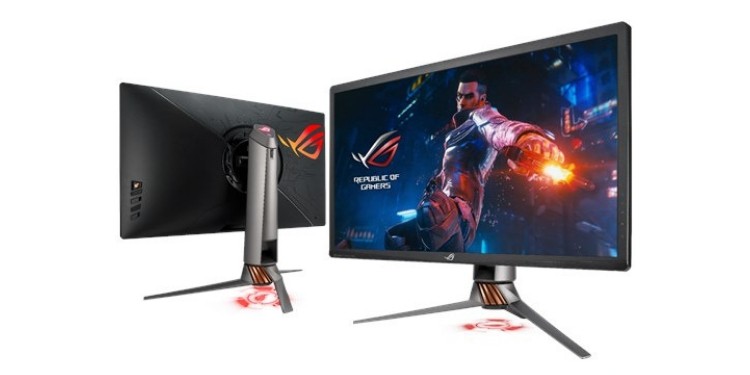
- Resolution: 3840 x 2160 (4K Ultra HD)
- PPI: ~163
- Refresh rate: 144 Hz
- VRR: G-Sync HDR
- Response time: 4 ms
- Panel type: IPS
- 144 Hz refresh rate, 4K resolution
- IPS panel with full HDR support
- No compromises
- The highest price, by far
Last but certainly not least is the ASUS ROG Swift PG27UQ. No doubt, this is the best overall 27-inch monitor.
But also… Good Lord.
4K Resolution. 144 Hz. G-Sync. HDR. IPS panel with 99% Adobe color gamut. And, most importantly, RGB lighting.
This is pretty much the definitive, no-compromises gaming monitor, but we feel like it’s worth noting that this is not a practical purchase. For anyone. The gaming rig that can run games at 4K, max settings, and 144 Hz… does not exist yet. This monitor isn’t built for today’s high-end, it’s built for tomorrow’s high-end. Bright side if you buy it: you won’t need to upgrade for a very, very long time, as long as you keep it safe.
If you can reasonably afford this monitor, then, by all means, go for it. It’s genuinely the best gaming display we can find on the market. It’s nowhere near practical or affordable for most, though… so if you aren’t ready to spend nearly $2000 on a monitor, we recommend one of the picks listed above.
Buying The Best 27 Inch Monitor For You
If you went through this article but didn’t understand all the specs and jargon we threw around, don’t worry. We’ve dedicated this section to a buying guide that you can use to get informed and make the right buying decision for you. These may all be 27-inch monitors, but there are plenty of meaningful differences between each model we’ve selected.
What is PPI, and why should I care?
What may draw your eye most is PPI. This is a measurement that we at PC Guide pioneered using in our monitor reviews before any competitors took to it. PPI stands for Pixels Per (Square) Inch, and it helps us give a better indication of how these monitors will actually compare to one another in terms of fidelity.
The bigger the number, the denser the pixels. The denser the pixels, the harder it is to individually see them, which is pretty important for monitors since you are usually sitting close to them.
When viewed at an average desktop viewing distance, you typically want your desktop display to have at least 90 PPI. This lines up with a 24-inch 1080p monitor, and it means you shouldn’t notice any blurring or pixelation unless you intentionally lean in and squint for it.
When buying a 27-inch monitor, it’s important that ideal PPI is maintained. The benefit of having a larger display is enjoying more immersion and screen real estate, but if you’re using, say, a 1080p resolution, things will be noticeably pixelated.
Below, we’ve listed the PPI for common resolutions at 27 inches:
- 720p (HD) – ~54 PPI. NOT recommended. At. ALL.
- 1080p (Full HD) – ~82 PPI. Not recommended, especially for desktop usage. May be fine when watching movies or playing games at a farther distance, though.
- 1440p (QHD) – ~109 PPI. Recommended for all usage. Provides a respectable boost in clarity over a 24-inch 1080p display in terms of PPI.
- 1800p (QHD+) – ~135 PPI. Recommended resolution for gaming on a 4K display. Still looks considerably better than 1440p, but at much less of a performance penalty as native 4K.
- 2160p (4K) – ~163 PPI. Excellent, and probably a bit overkill for gaming and media. Unparalleled in desktop usage, though.
Panel Type: TN vs IPS vs VA
Panel type refers to the underlying panel that powers your display. Depending on the panel type, things like viewing angles and color reproduction will be affected.
- TN – Lowest price; worst color and viewing angles. Best responsiveness. Recommended for budget gamers and eSports gamers.
- VA – Middle-ground in price and color reproduction. Viewing angles and responsiveness on par with IPS in most scenarios. Seems to handle HDR content better, if Samsung’s VA displays are any indication.
- IPS – Highest price, but best color reproduction and viewing angles. A bit less responsive than TN panels, but not to a noticeable extent to most– especially not on a high refresh rate display. Recommended for anyone who can afford it.
Refresh rate and VRR
Refresh rate is measured in Hertz, and it counts the number of times a display can “refresh” its image in a second. A similar-but-not-completely-identical metric in games is framerate, or frames per second (FPS). While games can often run well above 60 FPS on a PC, the refresh rate of your monitor will limit the FPS it can display. 60 Hz tops out at 60 FPS, 75 Hz at 75 FPS, and so on.
Because of this, higher refresh rates provide smoother gaming experiences. For this reason, 144 Hz displays are recommended for competitive gamers.
VRR refers to Variable Refresh Rate technology. To cut a long story short, something called “screen tearing” occurs when your framerate does not match your monitor’s refresh rate. V-Sync is usually used to combat this, but using traditional V-Sync results in input lag and worse performance.
Newer displays use FreeSync (AMD-made with Nvidia support) and G-Sync (Nvidia-exclusive). These are essentially-identical VRR technologies that allow the monitors to completely sync with the GPU, even when running below maximum refresh rate. This prevents screen tearing and provides a smoother gaming experience, making FPS dips less noticeable.
That being said, you’ll still need to use some other V-Sync solution if your in-game framerates are exceeding your monitor’s refresh rate. This is unlikely to be a problem on a 144 Hz display, but on a 60 Hz panel, you’ll likely want to use Nvidia Fast Sync or AMD Enhanced Sync to keep screen tearing from occurring when you exceed the VRR range.
HDR
HDR stands for high dynamic range. This is a primarily TV-centric technology, introduced with 4K TVs to provide brighter whites and darker blacks. This is accomplished by using more powerful and intricate lighting technology, and it comes at a pretty penny. Because of the relative size of monitors compared to 4K TVs, good HDR implementations are tough to pull off, and a lot of PC content has yet to even support the technology.
At this point in time, HDR is primarily recommended for those who moonlight as console gamers at their desks. Even the best desktop HDR solution won’t quite stand up to a living room TV solution, though, so keep that in mind.
Response Time
Response time is measured in milliseconds and generally measures the time it takes for a pixel to go from Gray to Gray (GTG). Non-standard response time measurements like MPRT occasionally pop up to make numbers look lower than they actually are, though.
While response time doesn’t directly measure input latency, it generally stands to reason that a 1 ms monitor will be more responsive than a 5 ms monitor, if only marginally. Refresh rate can muddy this up further, though.
We’ve ensured that the monitors in our roundup should all have excellent low input latency for gaming and common usage alike. Regardless, we’ll list common ranges below.
- 1 ms to 2 ms – The best, only achievable by TN panels.
- 3 ms to 4 ms – Good-to-great, depending on the refresh rate. Typical for high-end IPS and VN panels.
- 5 ms – Just okay. Common on decent IPS and VA panels, as well as budget TN panels.
- 6+ ms – Bad, especially for gaming purposes. Don’t bother. (Editor’s Note: Pretty sure we have never even recommended a 6+ ms monitor.)
